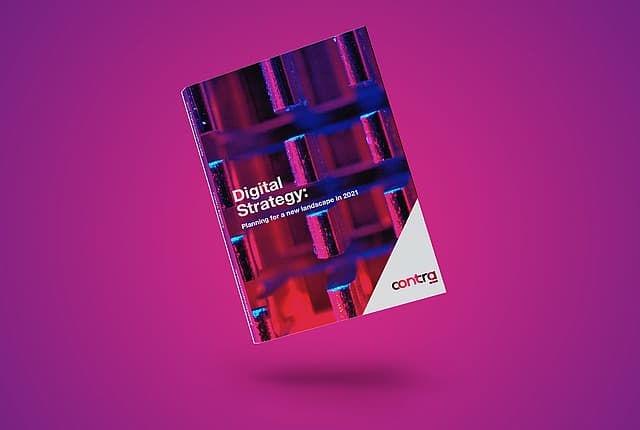Digital advertising: 4 hot topics to explore.
02.03.2021
Digital advertising is a beastly subject matter. With so many avenues, platforms, tools and techniques, it can be an overwhelming playing field to explore.
While it’s tough to master, it can provide transformative results for your business, so you’d be silly to not give it a good go.
But with so much change in the air since late 2019 it’s difficult to know where the land lies – what’s new, what’s trending, what your competitors doing, etc.
In this blog post we explore 4 interesting topics within digital advertising we think you should get to know this year.
Machine learning in advertising.
If your business is not using machine learning internally, it’s probably using it as an external service. Particularly if you do any paid advertising or organic search marketing.
Smart advertising has risen to prominence in recent times as advertising platforms have realised the barriers to entry for small businesses and people with little to no experience.
Smart ads help small business owners manage the complexity of targeted advertising in a simpler way.
Many of the Smart features are helpful, but some are less advantageous. For example, Smart Goals in Google Analytics decides what a positive outcome is as opposed to the business being able to set this manually.

In Google Ads, Smart campaigns are aimed at small businesses who have:
- A limited understanding of the platform
- A lack of time to invest
- Can’t afford/don’t want to pay for an advertising agency
These Smart campaigns simplify the process of managing ads for them.
However, with reduced control, insight – and frankly – space to be creative, you might find yourself questioning how smart the campaigns actually are.
How can you be sure you’re getting the best ROI, or even a decent ROI?
While the reduced control and insight might be an issue for some seasoned ad managers, they certainly have their place.
They can be a blessing for those who don’t have the same experience and confidence in the process, and it’s a good way to get on the platform and start learning.
AI-driven programmatic advertising.
Programmatic advertising is an auction-based system allowing advertisers or brands to purchase advertising space that publishers have to offer.

Both the advertiser and publisher can achieve better results through programmatic advertising if they harness AI. This is something we expect more brands to experiment with in 2021.
Programmatic ads delivered via artificial intelligence will automate ad purchases which allows brands and advertisers to become even more targeted in their pursuit of success.
The learning capabilities of artificial intelligence are well suited to the real-time nature of programmatic advertising.
AI is also able to process large datasets very quickly, making them perfect for serving a better experience for both advertisers and publishers.
Retargeting using video in display ads.
You’ve probably heard of both retargeting and display advertisements. But in case you haven’t, here are some quick definitions:
- Retargeting: retargeting campaigns kick in when someone leaves your website without making some desirable action i.e. contacting you or purchasing a product. After visiting certain pages, you can remarget to them and serve them with engaging ads to revert their attention back to your website. You probably see this a lot when you shop for clothing online. The pieces you checked out seem to follow you around the web for weeks.
- Display advertising: display ads use visuals like images and videos to promote your product or service. Display ads are placed on third-party websites in the form of banners, images and text ads.
In 2021 brands will experiment more with retargeted display ads to stimulate a response from the recipient.
The use of video, particularly, in ad banners will emerge as a growing trend in 2021, with many leading brands like Adobe using this method gloriously already.
Video boasts supreme engagement rates in most instances, so it’s going to be interesting to see which brands utilise video to fulfil the true potential of retargeting campaigns.
There is also increasing evidence that it significantly increases user engagement. Bannerflow recently reported that display ads featuring videos can boost click-through rates by over 15%.

Depersonalisation.
Rather counterintuitively, this is an interesting idea we came across at the Festival of Marketing last year.Despite the accelerating trend of creating more personalised experiences for your prospects and customers – where every effort is made to find out what your prospects are searching for, what they’re interested in, what they’re talking about, what people with similar characteristics are searching for, etc – does it not make sense to break the mould from time to time?
Think about it. We’re targeted so heavily based on our search history and other signals we have little control over – like our demographics – that we’re rarely ever introduced to new things.

As Steve Jobs once famously said:
“Some people say, “Give the customers what they want.” But that’s not my approach. Our job is to figure out what they’re going to want before they do. I think Henry Ford once said, “If I’d asked customers what they wanted, they would have told me, ‘A faster horse!'” People don’t know what they want until you show it to them. That’s why I never rely on market research. Our task is to read things that are not yet on the page.”
So if advertisers and brands consistently base their advertising on target audience research, aren’t we closing the door on opportunity within new segments?
Of course, this is not the right approach for many businesses, and I’m not saying budgets should be shifted and spent on people they know nothing about.
But there’s a place for advertising to simply advertise. For brand awareness and word of mouth; to generate fresh insight, and new opportunities and ideas.
Research conducted by a Dutch newspaper showed the impact that ditching creepily targeted ads can have on the performance of an advertising campaign.
Revenues from non-targeted advertising were higher than from targeted ones.
Think about traditional online dating. You fill out forms and create a profile based on all your interests, passions and dreams only to be paired with someone who matches the description of what you are looking for.
But where’s the fire with someone who thinks, talks and acts like you do? You’re better off dating yourself.
That’s where modern apps like Hinge, Bumble and *sanitizes* Tinder came into play.
On these current dating apps, you’re able to meet someone who can introduce you new things.
As consumers we don’t always know what we want. We only think we know what we want, because we can’t possibly know of everything we might want.
In the future, consider running a split test with more and less targeted ads, and see what the results are.
Even if the less targeted ads don’t perform as well as the targeted ads, at least you’ll be able to generate some new insights into other audiences.
Download our 2021 Digital Strategy Guide for more practical tips on your digital marketing strategy this year.


